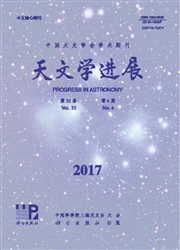

 中文摘要:
中文摘要:
简述了窄角天体测量中地面较差相位参考技术在射电波段以及近年来在红外波段的应用。给出了较差相位参考技术计算两颗星之间角距的基本公式;详细介绍了地面上红外波段实现较差相位参考技术VLTI—PRIMA的发展过程,和其结构、主要部件、科学能力,以及达到的目标和局限性。描述了2008年VLTI—PRIMA研制成功后进行的几次试验观测,并给出了与VLTI和NACO成像的比较结果。最后介绍了该工作的展望,如仪器硬件和软件的改进、VLTI第二代仪器GRAVITY的研制,以及根据PRIMA研制的经验,对我国研制仅有窄角天体测量功能的地基中等口径大视场光学望远镜提出几点建议。
 英文摘要:
英文摘要:
The application of ground-based differential phase referenced technique in radio and infrared band to narrow-angle astrometry is briefly described. The basic formula for calculation of angle vector on sky between two stars with this technique is given. The process of research into the narrow-angle dual-feed interferometer VLTI-PMIRA with the differential phase referenced technique in infrared band, as well as structure, main parts, capability and limit of this instrument are introduced in detail. Several experiments have been mentioned since the first astronomical light at VLTI-PRIMA in September 2008 and the comparison between the results obtained by VLTI- PRIMA and that from another imaging camera, NACO is shown. Finally, the future development of VLTI-PRIMA, such as the improvement of hardware and software, research work on the second generation VLTI instrument, GRAVITY as well as several suggestions about fabricating a ground- based wide field of optical telescope with middle aperture in China, which only has the capability of narrow-angle astrometry based on some experience of PRIMA, are pointed.
 同期刊论文项目
同期刊论文项目
 同项目期刊论文
同项目期刊论文
 期刊信息
期刊信息
